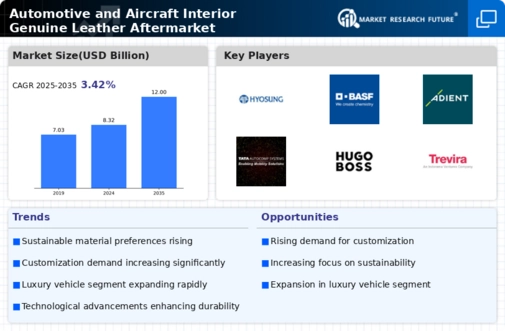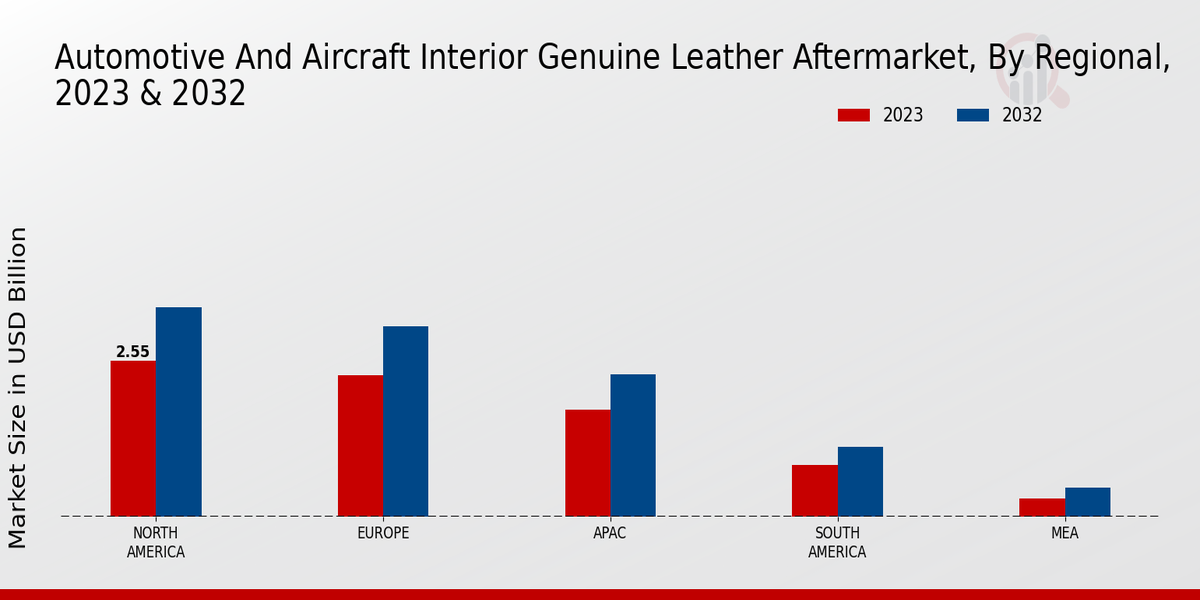Market Growth Projections
The Global Automotive and Aircraft Interior Genuine Leather Aftermarket Industry is projected to experience substantial growth over the coming years. With an estimated market value of 8.32 USD Billion in 2024, the industry is on a trajectory to reach 12.0 USD Billion by 2035. This growth is underpinned by a compound annual growth rate of 3.42% from 2025 to 2035, indicating a steady increase in demand for genuine leather products across both automotive and aircraft sectors. This upward trend reflects broader consumer preferences for quality materials and luxurious interiors, suggesting that the market will continue to thrive as it adapts to changing industry dynamics.
Growing Demand for Luxury Vehicles
The Global Automotive and Aircraft Interior Genuine Leather Aftermarket Industry experiences a notable surge in demand for luxury vehicles, which often feature premium leather interiors. As consumer preferences shift towards high-end automotive options, manufacturers are compelled to enhance interior aesthetics and comfort. This trend is reflected in the projected market value of 8.32 USD Billion in 2024, indicating a robust growth trajectory. The increasing purchasing power of consumers in emerging markets further fuels this demand, suggesting that the luxury segment will continue to expand, thereby driving the overall market for genuine leather interiors.
Consumer Preference for Customization
Consumer preference for customization significantly influences the Global Automotive and Aircraft Interior Genuine Leather Aftermarket Industry. As buyers seek personalized experiences, manufacturers are responding by offering bespoke leather options for vehicle interiors. This trend is particularly evident in the luxury automotive segment, where tailored interiors enhance brand appeal and customer satisfaction. The demand for unique designs and finishes encourages manufacturers to diversify their product offerings, thereby expanding the market. This customization trend not only caters to individual preferences but also fosters brand loyalty, suggesting a positive outlook for the industry as it adapts to evolving consumer expectations.
Sustainability and Eco-Friendly Materials
Sustainability emerges as a pivotal driver within the Global Automotive and Aircraft Interior Genuine Leather Aftermarket Industry. Manufacturers increasingly prioritize eco-friendly leather alternatives, responding to consumer demand for sustainable products. This shift is evident as companies invest in innovative production techniques that reduce environmental impact. The growing awareness of ecological issues influences purchasing decisions, leading to a potential increase in market share for sustainable leather options. As the industry adapts to these changes, it is likely that the market will witness a diversification of offerings, catering to environmentally conscious consumers while maintaining quality and luxury.
Rising Aircraft Production and Maintenance
The Global Automotive and Aircraft Interior Genuine Leather Aftermarket Industry benefits from the rising production and maintenance of aircraft. As air travel continues to grow, airlines are investing in upgrading their fleets, which often includes enhancing interior quality with genuine leather. This trend is particularly pronounced in the commercial aviation sector, where passenger comfort is paramount. The increasing number of aircraft deliveries and retrofitting projects suggests a sustained demand for high-quality interior materials. Consequently, this sector is likely to contribute significantly to the market's overall growth, aligning with the projected increase in market value to 12.0 USD Billion by 2035.
Technological Advancements in Leather Processing
Technological advancements play a crucial role in shaping the Global Automotive and Aircraft Interior Genuine Leather Aftermarket Industry. Innovations in leather processing techniques enhance the quality and durability of genuine leather, making it more appealing to manufacturers and consumers alike. For instance, the introduction of automated tanning processes and advanced finishing techniques improves the leather's resistance to wear and tear. These advancements not only elevate product standards but also contribute to cost efficiency in production. As a result, the market is poised for growth, with projections indicating a compound annual growth rate of 3.42% from 2025 to 2035, reflecting the positive impact of technology on the industry.










